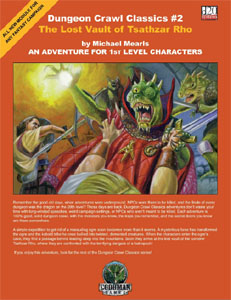IN THE SHADOW OF THE SPIRE
Character Background: Dominic Troya
 With the first prelude concluded, we now move on to introducing the rest of the main characters for In the Shadow of the Spire, starting with an Imperial priest named Dominic Troya.
With the first prelude concluded, we now move on to introducing the rest of the main characters for In the Shadow of the Spire, starting with an Imperial priest named Dominic Troya.
But while you’re reading that, I’m going to back up and continue talking about the first prelude featuring Tee and Agnarr. This prelude was a modified version of The Lost Vault of Tsathzar Rho, an adventure by Mike Mearls.
One of the issues I faced in designing the prelude was the non-standard party composition: Agnarr was a 1st-level barbarian and Tee was a 1st-level rogue. A barbarian is obviously pretty interchangeable with a fighter, but that still left two of the four core roles — cleric and wizard — unfilled.
But, truth be told, I find the typical hand-wringing over the need for a “standard party” to be a trifle overwrought. I’ve played with lots of odd-sized and odd-classed parties in D&D before, and I’ve virtually never found it to be a problem.
The one exception I’ve found is the mostly immutable need for some form of magical healing. Combat in D&D is strongly designed around the hit-and-heal cycle: The game assumes that you’re going to get hit and that you will then be healed.
Everything else, in my experience, is negotiable. Yes, if you’re missing other key roles in the party they will be missed. Without the consistency of a fighter, adventuring days will probably be shorter. Without the firepower of an arcanist, more powerful enemies will need to be avoided. Without a rogue, traps will become far more dangerous. And so forth. But, as I talked about in Fetishizing Balance, this is just a matter of adjusting the difficulty of encounters and the style of gameplay to suit the characters that the players want to play.
In fact, I’ve even played in a couple of short adventures without magical healing. This isn’t so much impossible as it is radically different. Without magical healing, combat in D&D almost instantly turns into a grim ‘n gritty exercise. Wounds take days or weeks to heal and any kind of serious injury — which can be almost trivial to receive — will force the party into rehabilitation. Hit point inflation still makes it possible for higher level characters to pull off some amazing things, but they’ll suffer for it.
In the case of the prelude, however, this grim ‘n gritty environment wasn’t what I was shooting for. (In no small part because I was using a published adventure as a foundation and I would have had to pretty much toss out the whole thing.) So I targeted the party’s shortcoming — magical healing — and provided a healing totem that had been given to Agnarr by the shamans of his tribe.
Mechanically this was basically just a wand of cure light wounds that worked with a command word instead of a spell trigger (so that it could be used without having a cleric in the party). And, if you’ll pardon the pun, it worked like a charm. Several encounters still needed to be adjusted due to the smaller group size, but with a large supply of magical healing available to them the barbarian and the rogue were still able to enjoy traditional-style romp through a dungeon crawl.












ARCHIVED HALOSCAN COMMENTS
Justin Alexander
Thanks, Lior. Had a typo in the file name. It’s been fixed.
Friday, September 26, 2008, 5:38:38 PM
Lior
The link to Dominic’s background is broken.
Friday, September 26, 2008, 11:40:15 AM
Justin Alexander
Your comment prompted me to finally dig into the CSS at HaloScan and figure out how to increase the font size on the comments. (It always annoyed me, too.) I did a fairly ham-fisted job of it, but it seems to have done the trick. Let me know if you’re seeing the same improvement.
As for the white-on-black design, that’s an intentional choice. Studies of readability on computer screens have demonstrated that it is more readable and less stressful on the eyes.
White-on-black is preferable in printed media because (a) it saves on ink cost and (b) unless you have incredibly precise printer, slight errors will make the white-on-black text significantly less readable than black-on-white text.
Because pretty much all of us learn to read from white-on-black text, the unfamiliar quality of the black-on-white design can create some issues. But the same readability studies indicate that, after a period of adjustment, almost everyone benefits from the white-on-black design.
It it’s really intolerable for you, I recommend doing what I do on those pages with white-on-black text (which begins to hurt my eyes after about an hour or so): Hit CTRL-A to select all the text.
On my machine, that makes it all white-on-blue — which is one of the best color combinations (which is why the early word processors used it).
Friday, September 26, 2008, 3:55:21 AM
Akiyama
I just want to say, I love your blog, both the D&D stuff and the politics stuff, but visually it’s just horrible! White text on a black background – ugh! And I would need a maginifying glass to read the comments!
Thursday, September 25, 2008, 7:48:47 AM
I’ve got a table of three, my wife and another couple, and I ended up going the route of a fourth “DM PC” who is the healer. Lore wise they’re the nephew of the group patron, and a bit of nervous shrinking violet, being forced out of the chapel to “see real life”, but they’re useful for both healing, and a promoted explainer. It’s not perfect, and I definitely have to resist the urge to have them do what I think the players should be doing, but it solves both the healing and simple combat numbers.